At the end of the Oligocene Climate change have made its presence known all across the globe. This change created chaos, turning once lush and fertile environment into dusty and windswept landscape. In this part of the world that would be known today as Mongolia, a mighty riven once meandered across the plains creating rich forest and lush savannah. But with the change in climate, this area is gripped by a severe drought that turned the river into nothing more than shallow muddy pools. The surrounding forest and savannah that was once green and harbored rich community of animals are now brown and devoid of its inhabitants.
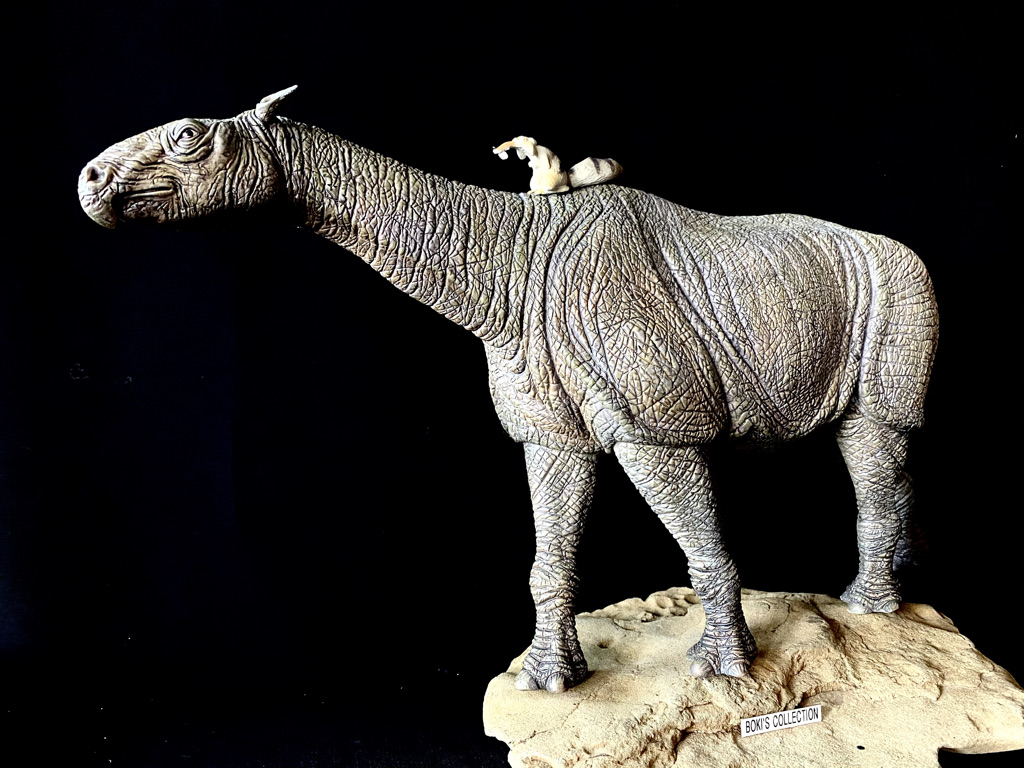
Like a mirage, a lone figure appears far in the distance. It slowly makes its way towards the dried riverbed; it briefly stops as if to survey its surroundings before continuing on. The lone figure is a young female Paraceratherium.
She has made this trip more than a dozen times before. Here, the animals congregated and temporarily abandoned their mostly solitary or small herding lifestyle for a few months to be with others of their own species. This special corner of Mongolia is the breeding ground for these giants, attracting animals from far away. Our young female had her first calf two years ago but lost it to the drought that was especially severe. Now ready to be a mother again, she embarks once again to this corner in search of a mate.
But the last few years has been different. Instead of finding hundreds of animals, only a few individuals dot the landscape including our female. Last year, there was only two other adult females and one immature male, and no adult bull.
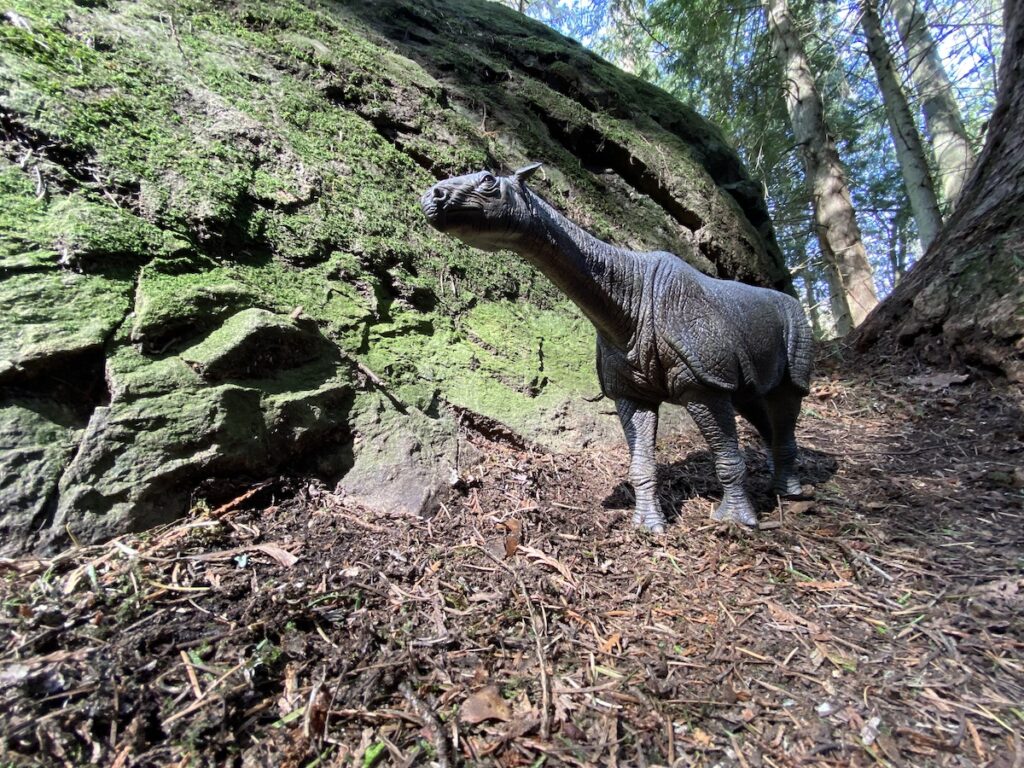
This year only our female can be seen. She scans the landscape for any signs of other Paraceratherium nearby, but only the vast empty grassland and the occasional gomphothere met her searching gaze. She starts to call, a low grunt that travels great distance. She stops and listen for any response. Silence. She repeats this call over and over again for several days, yet again and again she was only greeted by the sound of howling wind.
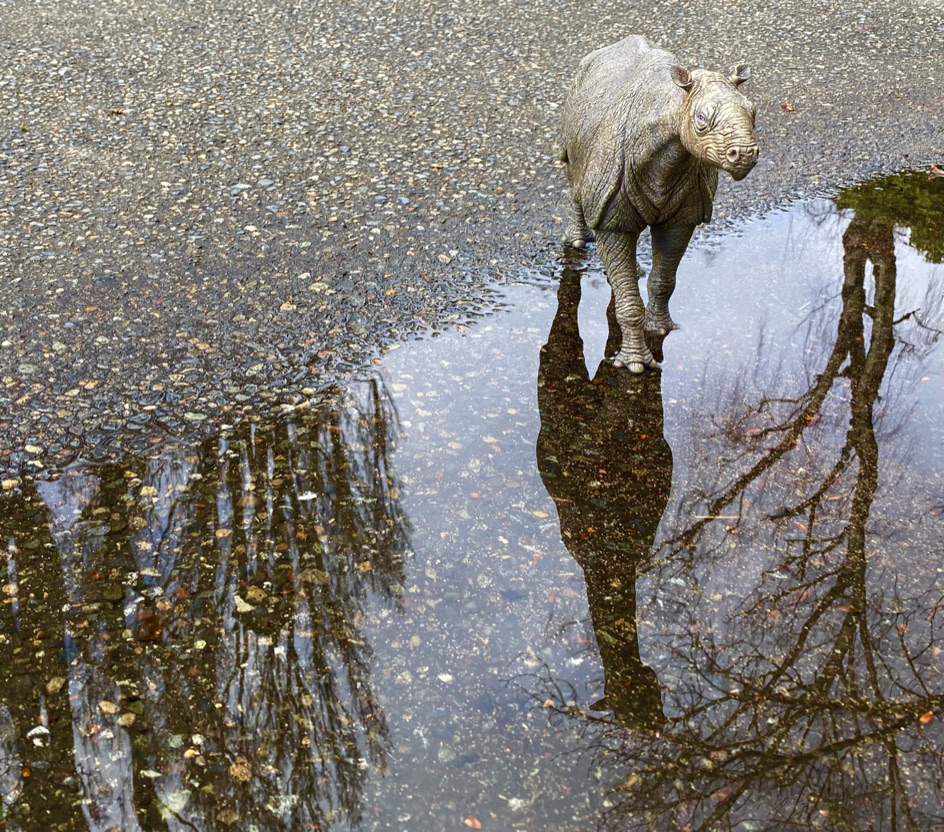
Exhaustion and hunger start to take its toll on our young female, her determination slowly fades as the days go by. She musters enough strength to move on and leave this area behind. As she makes her way, she kept calling in hopes that somewhere, and against the odds, it would be answered. She takes one last look before she vanishes in the distance. Despite her best efforts, her plaintive call that echoes through the vast forest and open plains will go unanswered. Unknown to her, she is the last of her kind.

Paraceratherium meaning “near horn beast” is a genus of hornless rhinoceros. Today, we associate rhinos with having two horns, but back in prehistoric times there were many rhinos that didn’t’ have horns. As it turns out, it’s not the horns that makes a rhino a rhino. It’s the shape of the teeth all rhinos share and Paraceratherium has those distinctive rhino teeth that leaves no doubt that it belongs to the group. It had a wide distribution having been found in China, India, Kazakhstan, and Pakistan, and lived from the early to late Oligocene.It is one of the largest land mammals to have ever walked the earth rivaling and even exceeding some dinosaurs in size and weight.
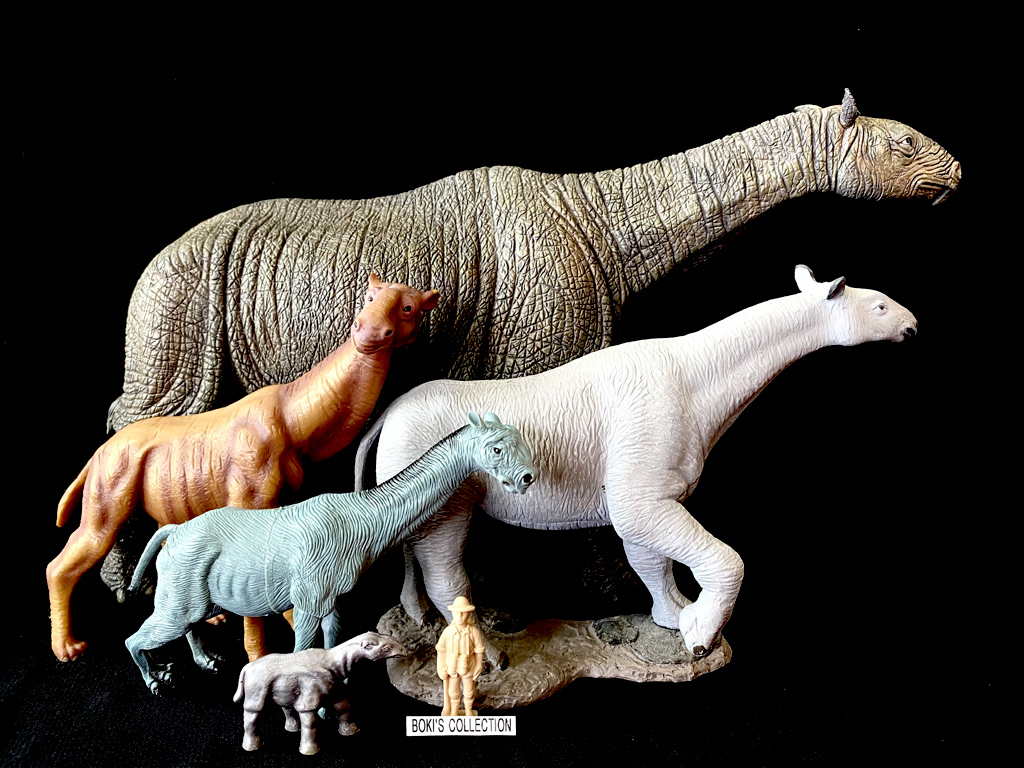
When it comes to toy figures of this animals, Collectors will be hard pressed to find one, let alone a good one. It is one of those animals that despite having found fame and recognition especially after being featured in an episode of the hugely popular WWPB series, is still rare in toy form. Ironically, it is actually one of the first prehistoric mammals to have a toy representation, appearing in Nabisco in the 1950’s, and Starlux of the 1970’s sets of prehistoric animals a few decades ago. But it would take a few more decades after before we see a figure from one of contemporary brands. CollectA did released one in 1:40 scale way back in 2009 (when they are still known as Procon), almost 12 years ago and would be the only decent one for years until now. There was also the 1:40 scale Faunacast resin figure that was briefly available but is now impossible to find.

IToy is known mostly for their dinosaur figures, but last year they surprised many when they unveiled a large and beautiful Paraceratherium figure. This was an answer to many collector’s prayer as this genus is one of the most requested and hoped for. Like many recent brands from China such as PNSO, GR toys, Nanmu, etc., IToy straddles the line between toy and high-end desktop models. These companies blurred the lines between what is typically considered a toy and what is high-end desktop models (once strictly made of resin material) with their exquisite figures made out of PVC (once the standard for toys). This Paraceratherium model is no exception.

It is priced higher than your typical PVC toy figure but a fraction of what a resin (mostly unfinished) model would cost. This higher priced is one reason why I held off buying it. But finally, having been able to afford it and to see it in person, I couldn’t help but wonder if it’s even fair to call this magnificent figure a toy despite being made of PVC.
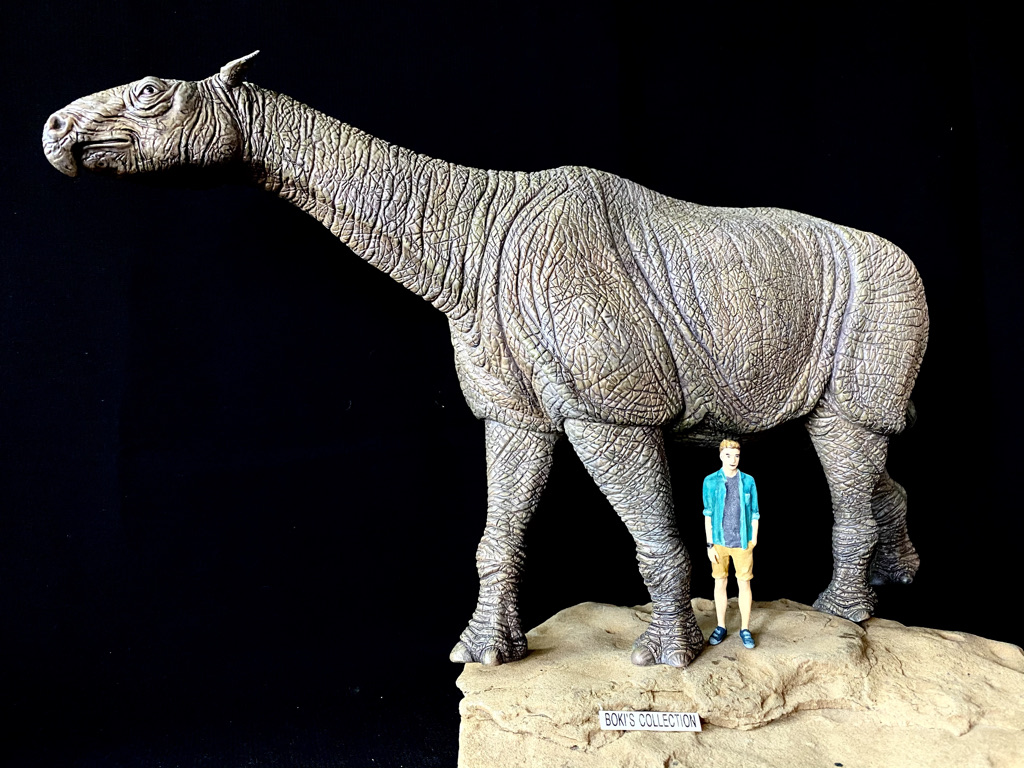
The first thing that would make an impression on you when you see it in person is just how large this figure truly is, its huge! Although officially billed as a 1:35 scale figure, it really is closer to the 1:20 scale range so you can just imagine how big it is, and its one solid plastic and not hollow.
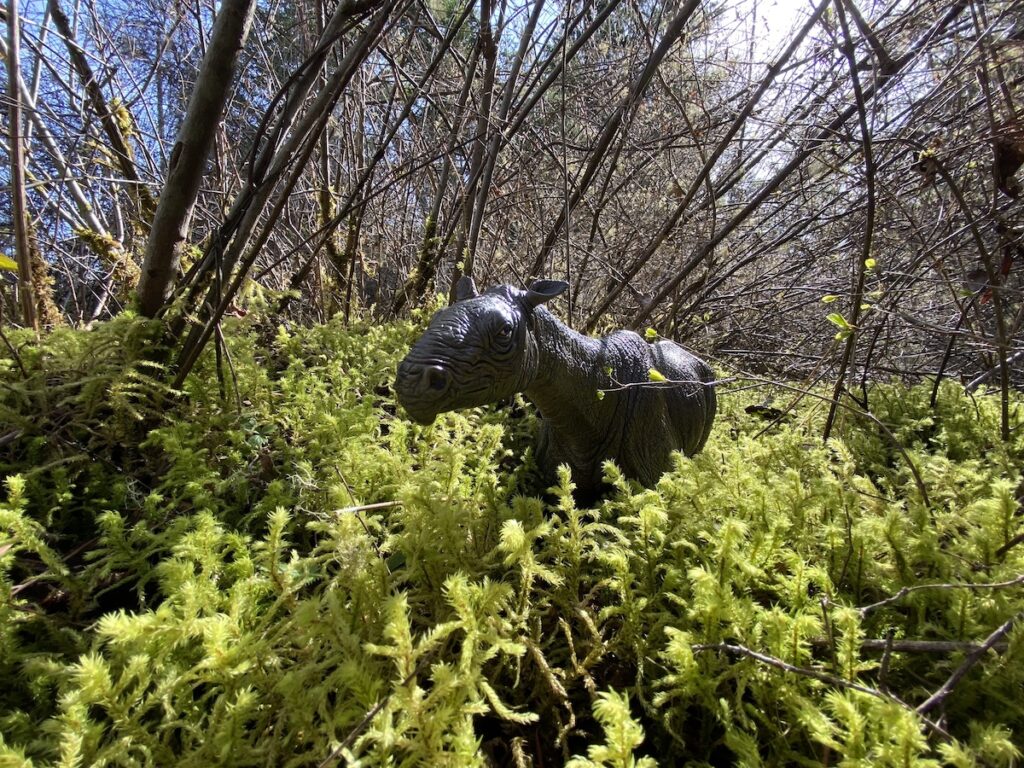
The figure measures close to 15″ inches long (excluding the tail) and 9″ inches tall, the head alone measure 2.5″ inches long and the tail 3″ inches long. Being one solid plastic, it weighs a whopping 2.5lbs. That is a lot of plastic, enough to make 2 medium size figures! This size makes it one of the largest figures in my collection. But despite this size, I’m glad that its actually around the 1:20 scale since the majority of prehistoric mammal figures from major brands are sculpted in this scale and makes a great companion and centerpiece for your collection of both extinct and extant animals.
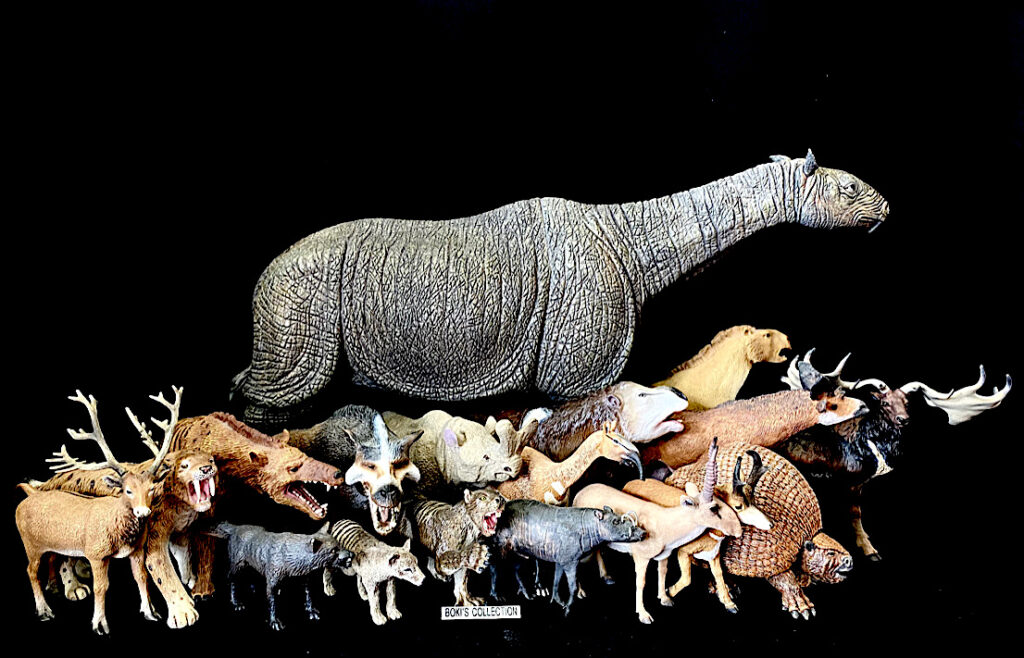
Paraceratherium have undergone many changes in how it was depicted through the years due to incomplete fossil material; to date, there are no complete skeleton found yet. Still, what was found is enough to give us some idea of what it may have looked like. In the earlier decades, it was common to see Paraceratherium being depicted as large animals with large body, short neck, and short legs. Early toy versions such as the Nabisco and Starlux figures captured these early interpretations of that time very well.Now with more fossil material, a new look emerged. It turns out that the animal had longer neck and legs than previously thought.

Adding to the confusion, it also has undergone changes in name: there was Indricotherium as well as Baluchitherium as the most recent and popular ones. These two popular names would be invalidated although one can still see them being used today. Despites it’s size, fossil of this animal are rather sparse and incomplete, and those fragments found scattered around its known range were erroneously given different names.

One of the first larger toy figure was produced by CollectA way back in 2009 and reflected the new taller and leaner look. Despite these early efforts, the CollectA’s figure looks more equine than rhino in its overall built. The IToy figure managed to incorporate all the new evidence regarding its built and produced a stunning figure that captured what the animal may have looked like.
The head is beautifully sculpted with lots of details in the form of skin wrinkles and deep cresses. The ears are slightly pulled back and are nicely sculpted. The eyes are beautifully painted and exudes a calm demeanor. Paraceratherium is believed to have a short prehensile upper lip similar to what we see in black and Indian rhinos to help maneuver leaves into their mouth. This feature is nicely incorporated in the figure and beautifully sculpted and shows it as curled inwards since the mouth is closed. On top of the snout, you can see its huge nostrils that looks flared perhaps the beast is taking a deep exhale. Paraceratheriums head are big measuring in at around 4.3 feet, and this figure beautifully captures its size and shape.
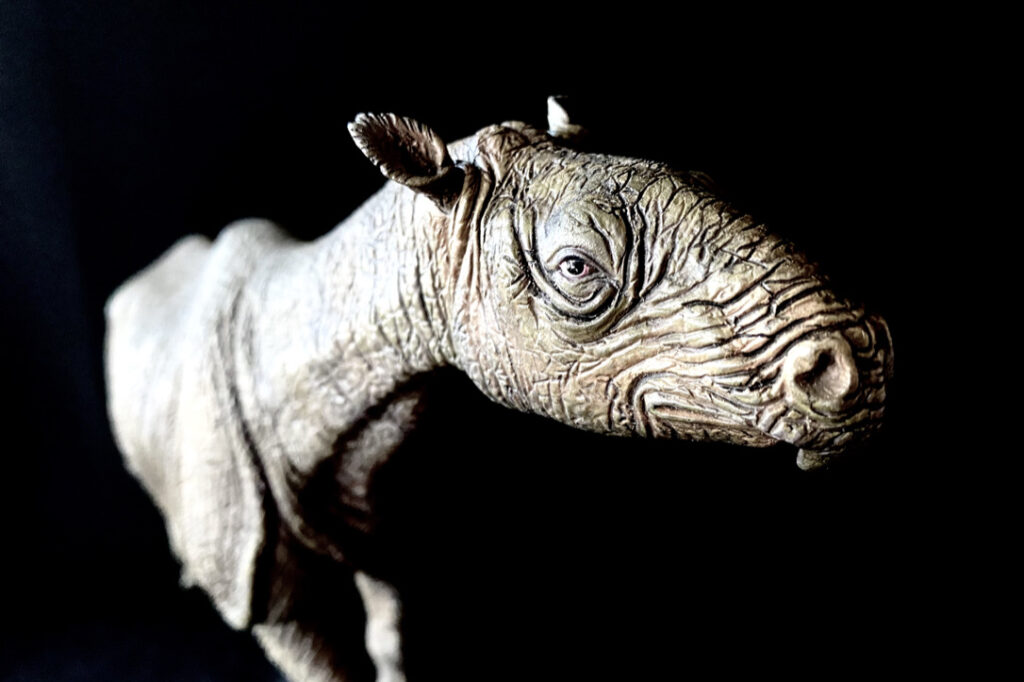
There are some differences in the skull material associated with the various Paraceratherium species especially the shape of the foreheads. Some show a dome-like foreheads while others are more flat. These differences are thought to be possibly due to sexual dimorphism. Interestingly despite its huge skull, the brain of Paraceratherium was not as large as one would think.
The neck is long and muscular as it should be to better hold up what must have been a pretty heavy head. This longer neck is a newer interpretation of what it may have looked like. To date, no complete set of vertebrae have yet been found, but from what is known, these vertebrae were very wide with lots of space for strong ligaments and muscle attachments. The neural spines were long and formed a hump along the back where neck muscle holding up the skull would be attached, and you can nicely see this feature on the model. In a lot of way, this is the closest or the mammalian equivalent of a sauropod.
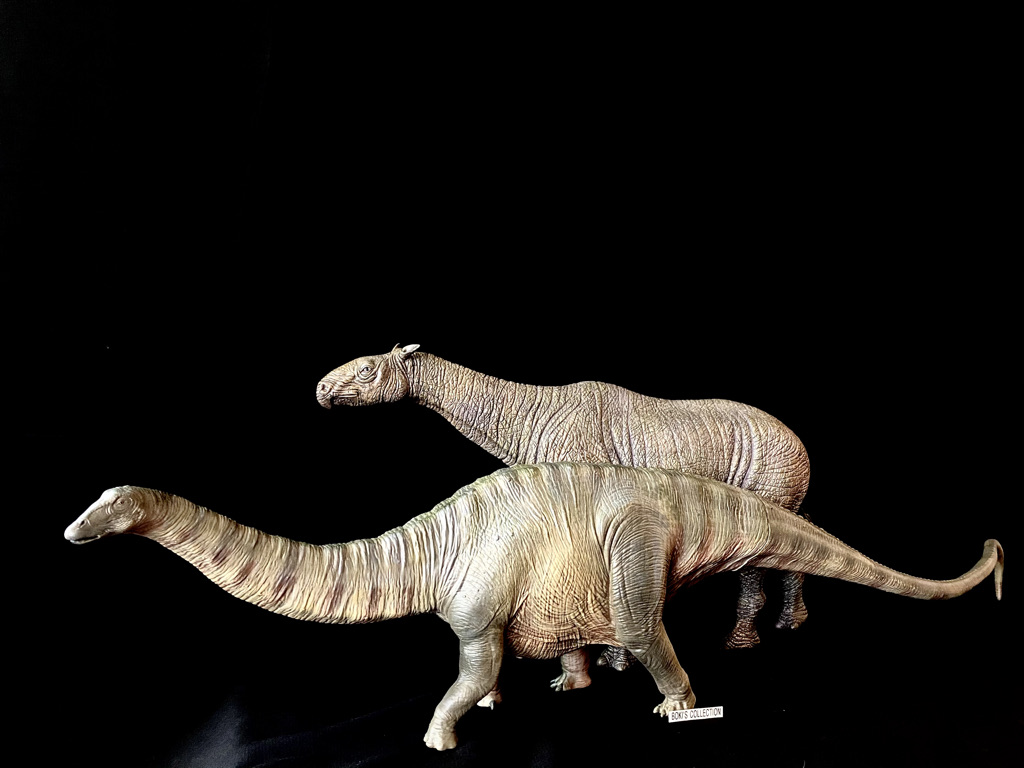
The body like many of its features has also undergone multiple look or interpretation but two looks are commonly seen in art; there is the robust smooth-skinned like we see in the African rhinos, to a more armor-clad body design seen on the Indian rhino species. It’s two predecessors have taken on the smooth-skinned African rhino version as can be seen in the CollectA and Faunacast models.
IToy went the Indian rhino look giving the figure that distinctive and prominent skin fold that looks like a body armor. This impressive fold of skins creates a blanket-like appearance as they overhang the front shoulders, the stomach, and the thigh regions of the body. These folds of skin are thick and full of deep wrinkles. The rest of the body is robust and nicely proportioned and rich in textures and details.

The skin details at times can look extreme especially when examined at close range or viewing close up photos, but that is true of almost all figures. But these becomes less pronounced when the figure is viewed, say from a foot away, from this distance, these skin details look nice and pleasing.
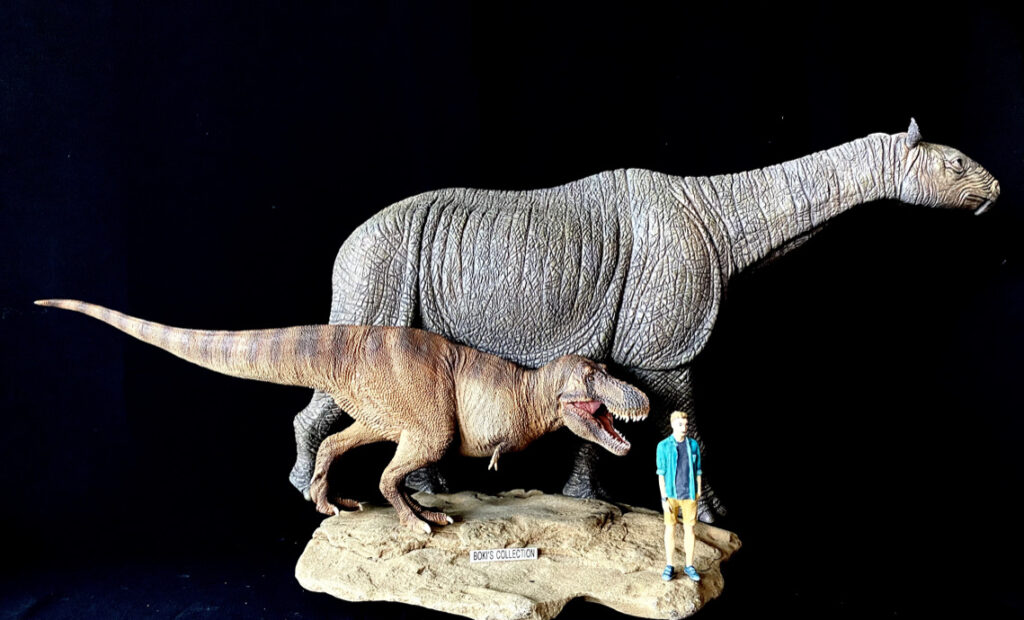
The limbs are large and robust as it should be. The musculature is very well sculpted and defined that you can see each muscle and tendons straining as they support such weight. The toes are big and splayed out, further emphasizing the weight they have to support. In a lot of ways, the limbs are very similar to elephants and sauropods than to modern day rhinos. The robust limb bones suggest that they are capable of fairly good speed. The front limbs have three toes.

The exact size of Paraceratherium is not known due to incompleteness of the fossil, but enough is known to give a good estimate and they range from 15- 20 feet tall and around 24 feet long. It makes them the largest known land mammal so far although the extinct elephant Palaeoloxodon may have rivaled it for that title and there is strong evidence that this size may have been the upper size limit of land mammals.

The color at first glance looks gray overall but look closer and you will see that there are subtle shades that are lighter. These lighter shades give a much-needed break from the monotonous gray and works well for an animal of this size. Like color, there are no known evidence that tell us what the skin of Paraceratherium may have looked like. All restorations are based on what we know of their extant relatives. On that note, the thick gray skin with lots of folds and mostly hairless skin that we associate with rhinos and elephants is what we see on this model.

Paraceratherium proved to be an adaptable animal and had a long reign surviving for 11 million years before going extinct. There is no one reason why they went extinct, but most likely a combination of multiple events. For sure the global climate change event that sent temperatures plummeting worldwide had a severe effect as it created disruption in the entire ecosystem worldwide. Paraceratherium was well adapted to the much warmer climate it evolved in during the Eocene and much of the Oligocene, feasting on the abundant plants and trees that covered much of their range. Their large size meant that they had little completion for food and not much big predators to fear since most have not yet reached the enormous size we see later.
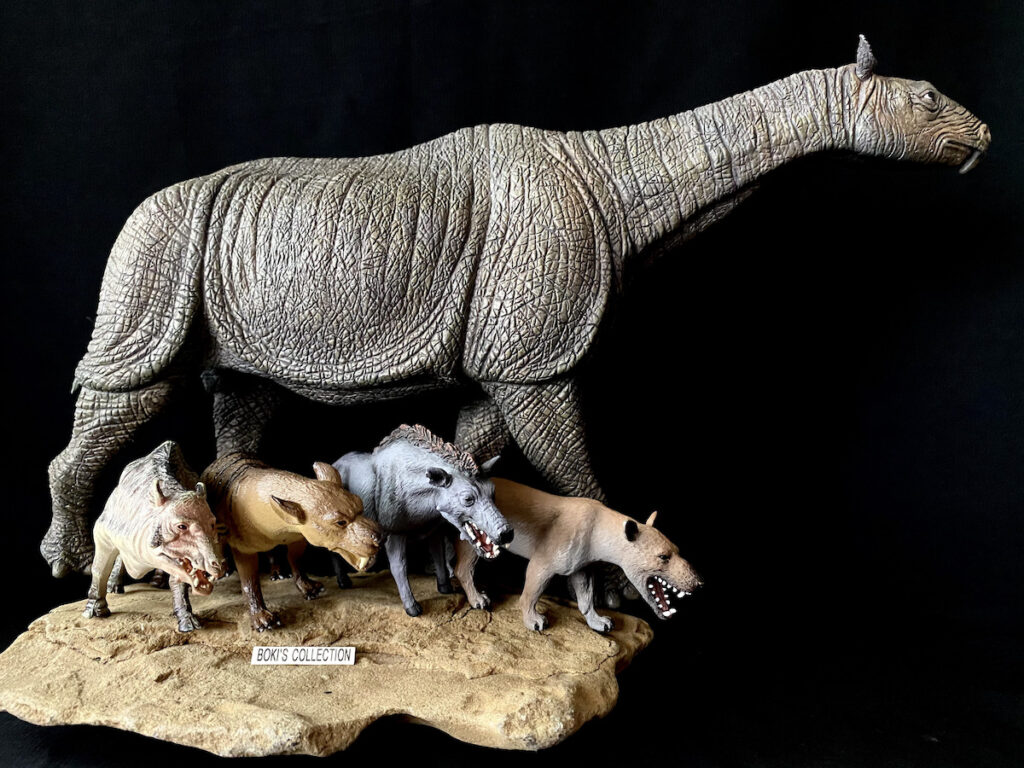
But with the climate change, these once semi-tropical environment would soon change into more open scrubland and savannah type environment with less wooded areas, reducing the suitable habitat for this giant beast. There is also the likelihood that as natural land bridge appeared due to sea levels dropping that some large migrant animals, both predators and herbivores, started to invade the Paraceratherium’s environment.
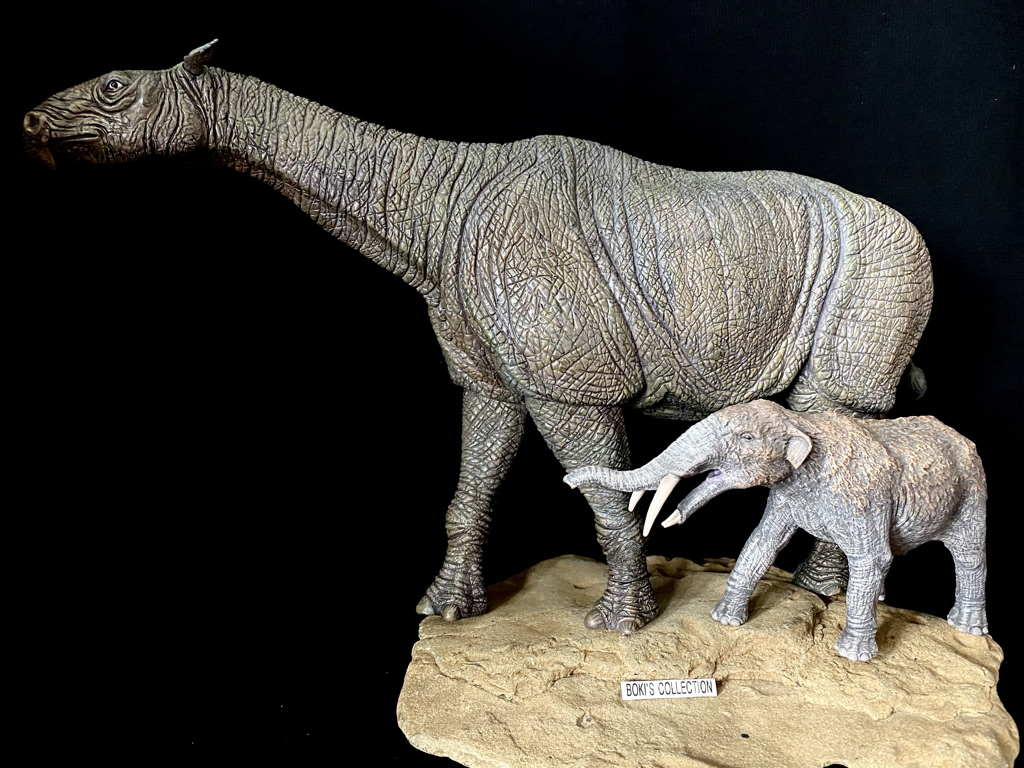
One such animal is the Gompotheres, an early elephant that would make an appearance towards the end of the Oligocene, like today’s elephants these exotic newcomers would help shape this new landscape by eating young trees and toppling older ones. This feeding behavior and indirect competition would accelerate the spread of open areas and would push the Paraceratherium into smaller and fragmented areas in search of food. And as these elephants spread out, the mighty Paraceratherium disappeared soon after. Large carnivores that also invaded the environment around the same time would add pressure to the already stressed populations of Paraceratherium. In the end, the vast landscape that offered protection and bounty, and which Paraceratherium enjoyed for millions of years, would not be resilient enough to protect it from all these new threats that are closing in.
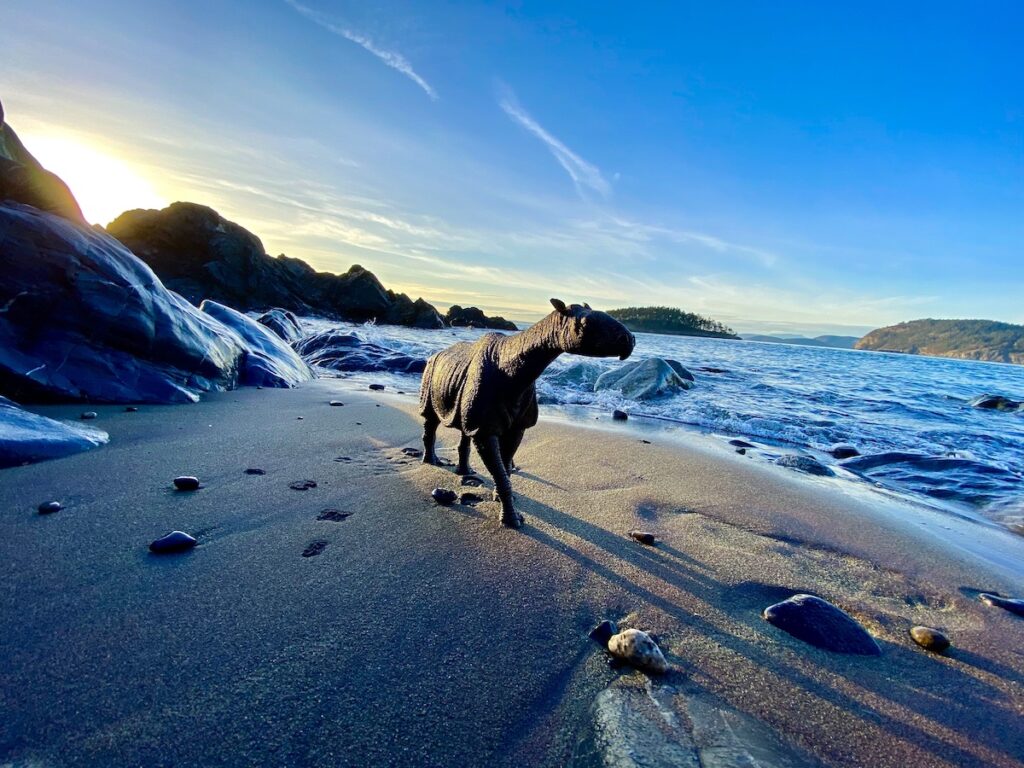
While we may never know how the last individual of a species may have spent its last days on earth, one thing is certain: extinction is a sad and lonely event. Our young female is sentenced to a solitary and isolated existence for the last remaining days of her life however long that may be. She will spend countless hours, days, months, or even years searching and calling for her lost kind without success. She has no idea of her situation or the sad fate that awaits her, and in her passing, her entire species species.
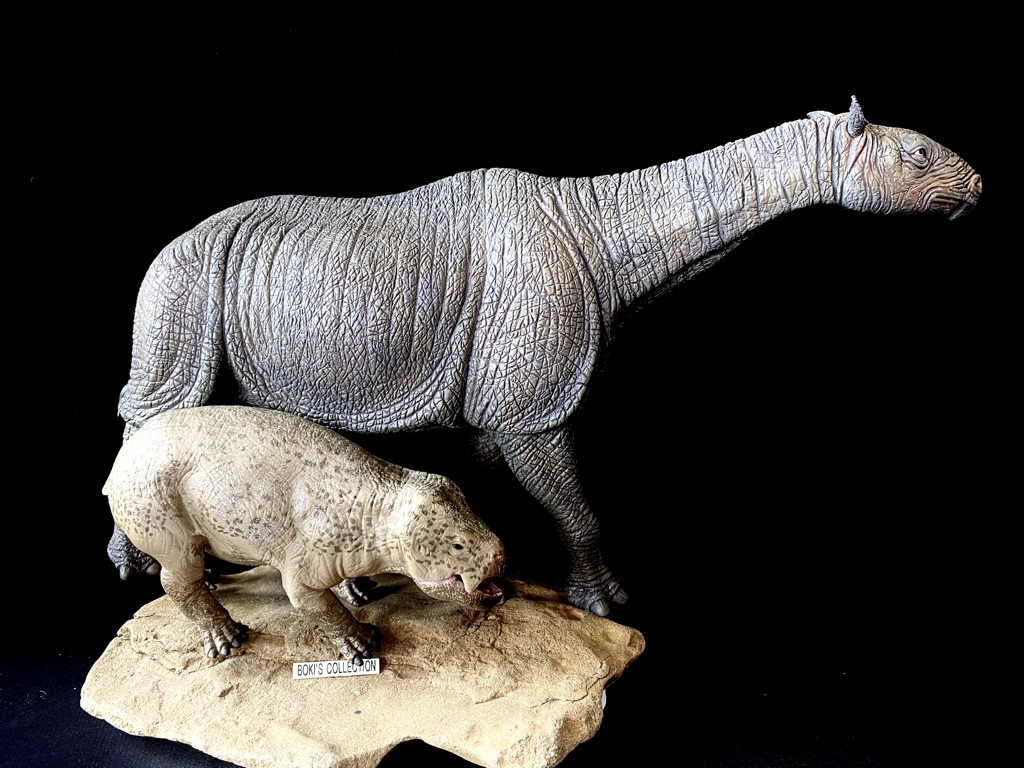
The Itoy Paraceratherium is truly a work of art that beautifully captures the essence of this amazing animal in a grand scale that would leave you in awe. It’s a beautifully sculpted and researched figure.The price may be high, but in my opinion very much well worth it. For anyone who is a fan of prehistoric mammals, this definitely is a must have figure.

Today, there are five species of rhino that are still with us today. Sadly, all are endangered, some on the verge of extinction, and may not see the dawn of the next century. Habitat destruction, uncontrolled poaching for their horns, and the alarming disappearance of available habitat all contributed to their uncertain future. As hardy as they are, if things don’t change quickly, these last remaining giants may soon join the Paraceratherium into oblivion.

That concludes our review of the IToy Paraceratherium. I hope you all enjoyed it and thanks for reading. Until the next review, stay safe and healthy!
Disclaimer: links to Ebay and Amazon on the DinoToyBlog are affiliate links, so we make a small commission if you use them. Thanks for supporting us!



Egyet értek Thialfival,ennél jobb nem lehet.Ez tényleg olyan jó,hogy ez már műalkotás.Kár,hogy nincs meg.
Wonderful review of an outstanding figure. Any chance you could share the scale on that giraffe you include? It’s bigger than most I’ve seen. I’m looking for a 1:20 giraffe. Thanks!
terrific review. The story line was really well done.
an impressive figure to be sure. I make the scale to be 1/22 to 1/24 depending on whose size estimate you go by. I usually go with Gregory Paul, so that would make it 1/22 for a full size adult….sex unknown.
A fantastic read as always. The ancillary examples from your collection are wonderful!
Beautiful, comprehensive review. Thank you! And that model.. words can’t do it justice. Most likely my favourite in my collection. It really is something special. The definitive paraceratherium. I can hardly imagine any other company improving on this.
Absolutely wonderful review, Boki! I’ve been looking forward to this figure for a while now, and your review has pushed me to buy it now!
Only thing I have to decide is base or no base. While the base looks beautiful, I’m not sure if it’s worth the extra $40-50 I see online.
Also I love your comparison photos with the other rhinoceros species. It’s great that they are all in scale with each other. Now if only I could get some elephants and mammoths in scale!
“Unknown to her, she is the last of her kind…” :´( No )’:
What a huge Review! Great work.
One hundred percent recommendable. She is the star figure of my collection without a doubt.
Quite the colossus!